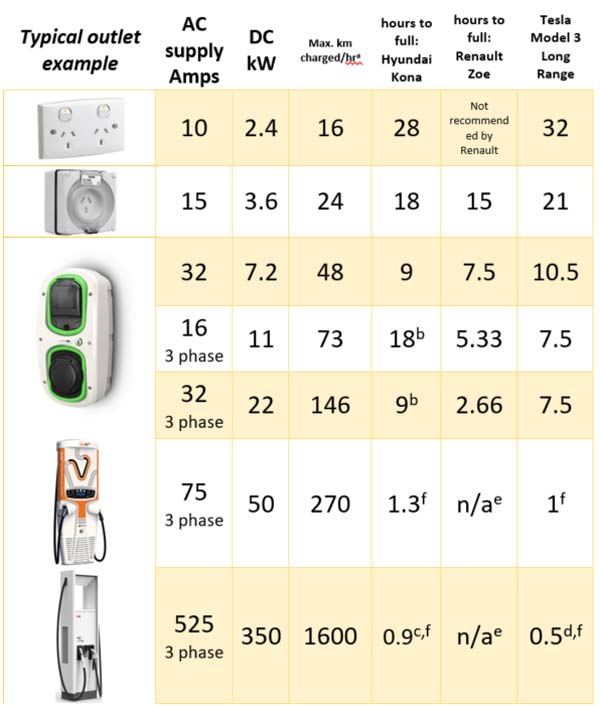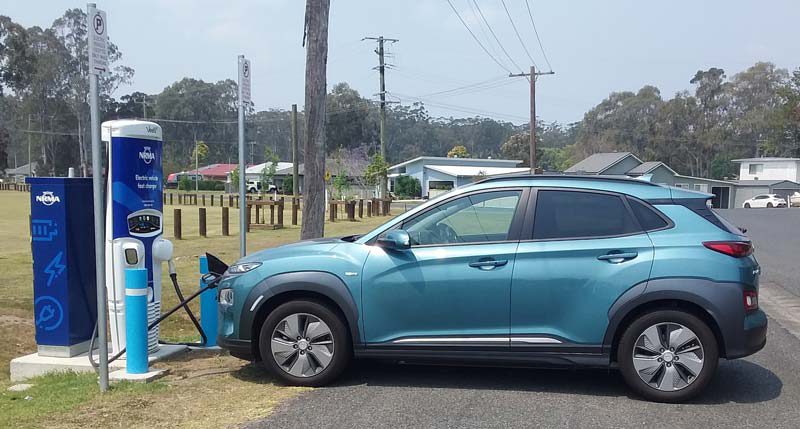Electric vehicle (EV) charging instead of refuelling is perhaps the biggest difference in ownership experience between EVs and internal combustion engine (ICE) vehicles – so it is no surprise that the hows and whens of charging are not yet well understood.
On the flip side: knowing what charging methods and choices are available is an important step on the path to driving electric – and the key to taking advantage of the change.
First up, AC charging at home or locally is the norm when it comes to charging, and real-world usage data shows it is used for over 90% of EV charging.
For local commuting in the longer-range EVs now available, it is not uncommon to charge only once every week or two, and to time that event to take make the best use of solar or off-peak electricity.
On the other hand, AC charging is not fast enough to give sensible travel times on long runs beyond the range of one charge – this is where the ‘other’ charging system (DC) comes into play. (See table 1).

Notes to Table 1:
All charge times listed are estimates only and are not endorsed by the manufacturer.
Please refer to official specifications when purchasing an electric vehicle.
- Assuming 15kWh/100km efficiency
- Kona has a max. 7kW (32A) single phase on-board charger.
– 3 phase 11kW is 16A/phase, Kona electric uses one 16A phase only
– 3 phase 22kW is 32A/phase, Kona electric uses one 32A phase only
- Kona has a maximum DC charge rate of 70kW
- Tesla M3 LR has a maximum DC charge rate of 250kW
- Renault Zoe in Australia does not have DC fast-charge
- To 80%
And this is also where much confusion seems to arise. DC charging an EV requires a different plug, and DC chargers themselves may be termed ‘fast-charge’, ‘rapid charge’, ‘ultra-fast charge’ and for Tesla, Supercharger 2.0 or 3.0. (See table 2).
Table 2: Common charging rates and names for DC chargers
| Common name | Maximum charge rate | Km charged/hra (km charged/15 min) |
| DC Fast-charge | 50kW | 270 (68) |
| Rapid charge | 100kW | 460 (115) |
| Ultra-fast charge | 350kW | 1600 (400) |
| Tesla Supercharger 2.0 | 120kWb | 550 (137) |
| Tesla Supercharger 3.0 | 250kW | 1100 (275) |
Notes to Table 2:
- Assuming 15kW/100km efficiency.
- Some Tesla 2.0 Superchargers have been software upgraded to a maximum 145kW rate.
So why the difference? Well, batteries must be charged with DC current – but our grid supply is AC. Consequently, charging a battery means converting grid-supplied AC to DC for the battery using what is called an ‘inverter’.
Low power inverters are quite cheap and small – so inverters to suit the lower power availability in homes and the like are easily built into the car. Bigger inverters to provide the high charge rates needed for DC fast-charging are very large, heavy and expensive – so they need to be fixed items with big connections to three phase grid power.
Given the limits of household electricity supply (and AC to DC inverter size and cost), EV manufacturers mostly stick to an upper limit of 32 Amps (7.2kW) for AC charging, although some go as high as 11kW three phase (or even 22kW three phase in the case of the Renault Zoe).
So there you have it: AC charging is, therefore, perfectly suited for a full overnight charge at the cheapest tariff at home, or for smaller top-ups in the down-time between trips.
Having the AC to DC inverter built into the car also makes it extremely handy to be able to charge at any available power point if the need arises. AC chargers are mostly installed in homes, offices, etc, where cars are parked.
For long-distance travel, the inverter is moved outside the car and connects to a different part of the inlet plug, bypassing the on-board inverter to supply DC direct to the battery.
Therefore DC chargers are different in appearance and plug type, and mostly to be found on the major intercity routes in roadhouses and shopping strips.

Bryce Gaton is an expert on electric vehicles and contributor for The Driven and Renew Economy. He has been working in the EV sector since 2008 and is currently working as EV electrical safety trainer/supervisor for the University of Melbourne. He also provides support for the EV Transition to business, government and the public through his EV Transition consultancy EVchoice.

